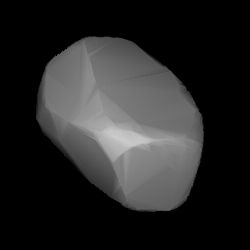
 Modelled shape of Katyusha from its lightcurve | |
| Discovery[1] | |
|---|---|
| Discovered by | T. Smirnova |
| Discovery site | Crimean Astrophysical Obs. |
| Discovery date | 16 December 1971 |
| Designations | |
| (1900) Katyusha | |
Named after | Yekaterina Zelenko (Soviet war pilot)[2] |
| 1971 YB · 1938 WM 1941 SS1 · 1950 LS 1953 GL1 · 1961 WD 1969 DC | |
| main-belt · Flora family[3] | |
| Orbital characteristics[1] | |
| Epoch 4 September 2017 (JD 2458000.5) | |
| Uncertainty parameter 0 | |
| Observation arc | 63.59 yr (23,226 days) |
| Aphelion | 2.5075 AU |
| Perihelion | 1.9116 AU |
| 2.2096 AU | |
| Eccentricity | 0.1348 |
| 3.28 yr (1,200 days) | |
| 354.20° | |
| 0° 18m 0.36s / day | |
| Inclination | 6.5426° |
| 281.91° | |
| 142.40° | |
| Physical characteristics | |
Mean diameter | 8.820±0.097 km[4] 9 km[5][6] |
| 9.4999 h (0.39583 d)[1] | |
| 0.29[5][6] 0.299±0.037[4] | |
| S[3] | |
| 12.2[1] | |
1900 Katyusha (prov. designation: 1971 YB) is a stony background asteroid from the inner asteroid belt, approximately 9 kilometers in diameter. It was discovered on 16 December 1971, by Russian astronomer Tamara Smirnova at the Crimean Astrophysical Observatory in Nauchnyj, on the Crimean peninsula[7] and named in honor of Yekaterina Zelenko, the only woman to credited with conducting an aerial ramming.[2]
Katyusha is a member of the Flora family, one of the largest groups of stony asteroids in the inner main-belt.[3] It orbits the Sun in the inner main-belt at a distance of 1.9–2.5 AU once every 3 years and 3 months (1,200 days). Its orbit has an eccentricity of 0.13 and an inclination of 7° with respect to the ecliptic.[1]
This minor planet was named in honor of Ukrainian Yekaterina Zelenko (1916–1941), a war pilot and Hero of the Soviet Union, known for being the only woman who had ever executed an aerial ramming. The asteroid's name "Katyusha" is a petname for Ekaterina.[2]
It rotates around its axis with a period of 9.4999 hours and with a brightness variation of 0.72 magnitude, indicating a non-spheroidal shape.[8]
According to the survey carried out by NASA's Wide-field Infrared Survey Explorer with its subsequent NEOWISE mission, Katyusha measures between 8.820 and 9 kilometers in diameter and its surface has an albedo between 0.29 and 0.299.[4][5][6] Katyusha has been characterized as a S-type asteroid.[3]